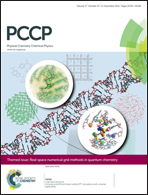The effect of meta coupling on colour purity, quantum yield, and exciton utilizing efficiency in deep-blue emitters from phenanthroimidazole isomers†
Abstract
meta-Coupling isomers usually exhibit bluer emission than do the para-isomers, but the loss of efficiency with respect to photoluminescence (PL) and electroluminescence (EL) is an inevitable result in most cases, particularly for deep blue emitters. In this study, three blue emitting isomers, 4,4′-bis(1-phenyl-phenanthro[9,10-d]imidazol-2-yl)biphenyl (BPPI), 3,4′-bis(1-phenyl-phenanthro[9,10-d]-imidazol-2-yl)biphenyl (L-BPPI) and 3,3′-bis(1-phenyl-phenanthro[9,10-d]-imidazol-2-yl)biphenyl (Z-BPPI), were chosen as model compounds to investigate the essential reason behind the meta-coupling effect due to their different coupling forms, viz. para–para, para–meta, and meta–meta, respectively, in similar dimeric phenanthroimidazole frameworks. A combination of detailed photophysical data, device performance and DFT calculations for the excited state provided valuable information. In particular, the relationship between certain key parameters in calculations as well as PL or EL properties was confirmed, such as oscillator strength and quantum yield, among others, which could effectively reduce the issues related to synthesis and characterisation using prior computer simulations. Good agreement was observed in the results obtained from calculation and experiments, and it was concluded that meta-tuning barely realised improvement in EL, unless some special excited states formed or an exciton conversion channel appeared, as in the case of reverse intersystem crossing.


 Please wait while we load your content...
Please wait while we load your content...